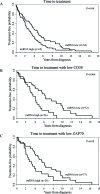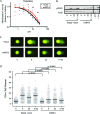The long noncoding RNA, treRNA, decreases DNA damage and is associated with poor response to chemotherapy in chronic lymphocytic leukemia
- PMID: 28412730
- PMCID: PMC5432228
- DOI: 10.18632/oncotarget.15401
The long noncoding RNA, treRNA, decreases DNA damage and is associated with poor response to chemotherapy in chronic lymphocytic leukemia
Abstract
The study of long noncoding RNAs (lncRNAs) is an emerging area of cancer research, in part due to their ability to serve as disease biomarkers. However, few studies have investigated lncRNAs in chronic lymphocytic leukemia (CLL). We have identified one particular lncRNA, treRNA, which is overexpressed in CLL B-cells. We measured transcript expression in 144 CLL patient samples and separated samples into high or low expression of treRNA relative to the overall median. We found that high expression of treRNA is significantly associated with shorter time to treatment. High treRNA also correlates with poor prognostic indicators such as unmutated IGHV and high ZAP70 protein expression. We validated these initial findings in samples collected in a clinical trial comparing the nucleoside analog fludarabine alone or in combination with the alkylating agent cyclophosphamide in untreated CLL samples collected prior to starting therapy (E2997). High expression of treRNA was independently prognostic for shorter progression free survival in patients receiving fludarabine plus cyclophosphamide. Given these results, in order to study the role of treRNA in DNA damage response we generated a model cell line system where treRNA was over-expressed in the human B-CLL cell line OSU-CLL. Relative to the vector control line, there was less cell death in OSU-CLL over-expressing treRNA after exposure to fludarabine and mafosfamide, due in part to a reduction in DNA damage. Therefore, we suggest that treRNA is a novel biomarker in CLL associated with aggressive disease and poor response to chemotherapy through enhanced protection against cytotoxic mediated DNA damage.
Keywords: DNA damage; chronic lymphocytic leukemia; lncRNA; prognostic factor; treRNA.
Conflict of interest statement
The authors declare no potential conflicts of interest.
Figures




References
-
- Hamblin TJ, Davis Z, Gardiner A, Oscier DG, Stevenson FK. Unmutated Ig V(H) genes are associated with a more aggressive form of chronic lymphocytic leukemia. Blood. 1999;94:1848–1854. - PubMed
-
- Damle RN, Wasil T, Fais F, Ghiotto F, Valetto A, Allen SL, Buchbinder A, Budman D, Dittmar K, Kolitz J, Lichtman SM, Schulman P, Vinciguerra VP, et al. Ig V gene mutation status and CD38 expression as novel prognostic indicators in chronic lymphocytic leukemia. Blood. 1999;94:1840–1847. - PubMed
-
- Dohner H, Stilgenbauer S, Benner A, Leupolt E, Krober A, Bullinger L, Dohner K, Bentz M, Lichter P. Genomic aberrations and survival in chronic lymphocytic leukemia. The New England Journal of Medicine. 2000;343:1910–1916. - PubMed
-
- Claus R, Lucas DM, Stilgenbauer S, Ruppert AS, Yu L, Zucknick M, Mertens D, Buhler A, Oakes CC, Larson RA, Kay NE, Jelinek DF, Kipps TJ, et al. Quantitative DNA methylation analysis identifies a single CpG dinucleotide important for ZAP-70 expression and predictive of prognosis in chronic lymphocytic leukemia. Journal of Clinical Oncology. 2012;30:2483–2491. - PMC - PubMed
MeSH terms
Substances
Grants and funding
LinkOut - more resources
Full Text Sources
Other Literature Sources
Research Materials

